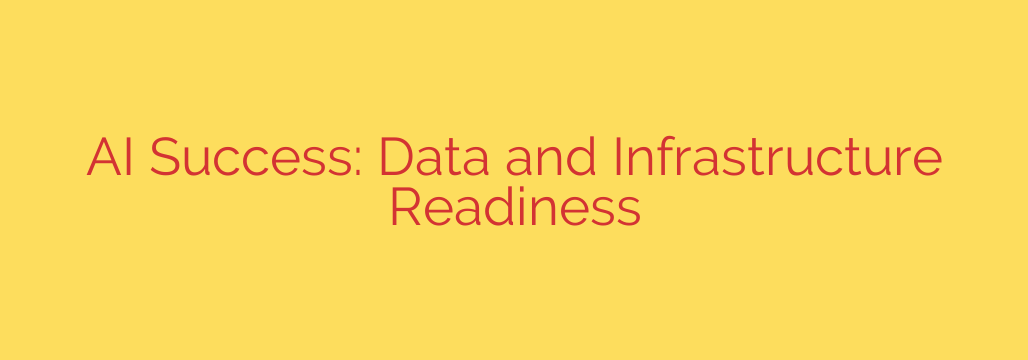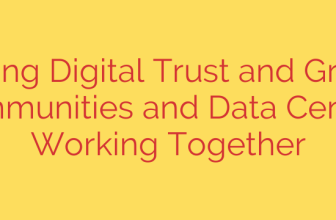
Is Your Business Ready for AI? A Guide to Data and Infrastructure Readiness
Artificial intelligence is no longer a futuristic concept; it’s a powerful business tool that promises to revolutionize industries, streamline operations, and unlock unprecedented growth. Yet, for every AI success story, there are countless projects that stall, underperform, or fail entirely. The reason often has little to do with the sophistication of the algorithm and everything to do with the foundation it’s built upon.
Successful AI implementation hinges on two critical pillars: a robust data strategy and a resilient, scalable infrastructure. Without getting these right, even the most advanced AI model is destined for failure. This guide explores how to prepare your organization by mastering these foundational elements.
Pillar 1: Mastering Your Data Strategy for AI
Data is the lifeblood of artificial intelligence. An AI model is only as intelligent, accurate, and unbiased as the data used to train it. Before embarking on any AI initiative, you must first assess and strengthen your organization’s data readiness.
The Quality and Quantity Mandate
The principle of “garbage in, garbage out” has never been more relevant. AI models, particularly deep learning and machine learning systems, require vast amounts of high-quality, relevant data to learn effectively.
- Quality: Your data must be clean, accurate, complete, and properly labeled. Inconsistent or erroneous data will directly lead to flawed models and unreliable predictions.
- Quantity: While quality is paramount, you also need sufficient data volume to train a model that can recognize complex patterns and generalize to new, unseen information.
Actionable Tip: Begin with a comprehensive data audit. Identify your key data sources, assess their quality, and implement data cleansing processes to standardize formats and remove inaccuracies. Investing in data hygiene is the most crucial first step in any AI journey.
Data Accessibility and Governance
The best data in the world is useless if your AI systems can’t access it. A common roadblock is the presence of “data silos,” where valuable information is fragmented across different departments and stored in incompatible systems.
A successful AI strategy requires a unified approach. This means breaking down silos and creating a centralized or well-integrated data environment. Furthermore, strong data governance is essential. This involves establishing clear policies for data management, usage, privacy, and security.
A comprehensive data governance framework ensures your AI initiatives are not only effective but also compliant with regulations like GDPR and CCPA. This builds trust with customers and minimizes legal and financial risks.
Building Robust Data Pipelines
Data isn’t a static asset; it’s constantly flowing into your organization. To fuel your AI models with fresh, relevant information, you need automated data pipelines. These are systems designed to efficiently handle the entire data lifecycle: ingestion, storage, processing, transformation, and analysis.
Modern data pipelines are the circulatory system of your AI strategy, ensuring that clean data moves seamlessly from its source to your machine learning models. This automation reduces manual effort, minimizes errors, and allows your models to adapt to new information in near real-time.
Pillar 2: Building a Resilient AI Infrastructure
Once your data is in order, you need the right infrastructure to process it and run your AI models. AI workloads are computationally intensive and demand more than a traditional IT setup can provide.
Scalable Compute Power
Training complex AI models requires immense processing power, often leveraging specialized hardware like Graphics Processing Units (GPUs) and Tensor Processing Units (TPUs). The key here is scalability. You need an infrastructure that can handle a small-scale pilot project today and scale up to a full production workload tomorrow without a complete overhaul.
This is where cloud computing platforms shine. Cloud providers offer on-demand access to powerful AI-optimized hardware, allowing you to pay only for the resources you use and scale effortlessly as your needs grow. While on-premise solutions offer more control, a hybrid or cloud-first approach provides the flexibility most organizations need to get started.
Adopting an MLOps Framework
Developing a model is just one part of the process. You also need to deploy, monitor, manage, and retrain it over time. This entire lifecycle is managed through a practice known as MLOps (Machine Learning Operations).
MLOps is essentially DevOps for machine learning. It applies principles of automation and continuous integration/continuous delivery (CI/CD) to AI models. Implementing an MLOps framework is critical for moving AI projects from the experimental phase to reliable, enterprise-grade production. It ensures your models remain performant, auditable, and easy to update.
Prioritizing End-to-End Security
AI systems introduce new security challenges. Your data, your trained models, and the infrastructure they run on are all high-value assets that must be protected. A security-first mindset is non-negotiable.
This means securing the entire stack:
- Data Security: Protecting data both at rest and in transit with strong encryption and access controls.
- Model Security: Safeguarding your proprietary models from theft or tampering.
- Infrastructure Security: Hardening the servers, networks, and cloud environments where your AI workloads run.
Your security strategy must evolve alongside your AI initiatives to protect against new and emerging threats.
Your Roadmap to AI Readiness
Preparing for AI is a strategic initiative, not just a technical one. Success is built on a solid foundation of deliberate planning and investment. By focusing on mastering your data and modernizing your infrastructure, you transform AI from a buzzword into a tangible driver of business value. Get these pillars right, and you’ll be well on your way to a successful and sustainable AI future.
Source: https://datacenternews.asia/story/data-readiness-infrastructure-drive-enterprise-ai-success








